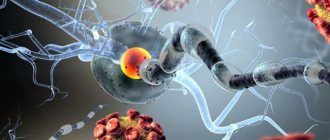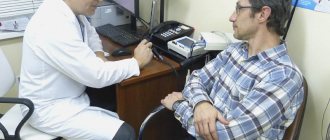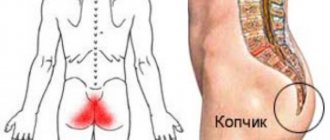More details about other diseases starting with the letter “A” here: Abdominal migraine, Absence, Brain abscess, Abuse headache, Agnosia, Pituitary adenoma, Adrenoleukodystrophy, Acalculia, Akathisia, Alternating syndromes, Amaurotic idiocy, Werdnig-Hoffmann amyotrophy, Kugelberg amyotrophy- Velandera, Amnesia, Angioneurosis, Cerebral Aneurysms, Anomalies of Brain Development, Chiari Malformation, Kimerli Malformation, Apallic Syndrome.
What is Werdnig-Hoffmann amyotrophy?
Werdnig-Hoffmann amyotrophy is a disease characterized by the occurrence of malignant spinal muscular atrophy in the first years of a newborn baby. Children aged from one to one and a half years are most susceptible to this disease. As the disease progresses, there is an increase in diffuse loss of vitality of some muscle structures, which is accompanied by paresis, at some points capable of achieving complete paralysis. Often, specialists observe such manifestations simultaneously with bone pathological processes and congenital abnormalities in development. Treatment of the described phenomenon has a weak effect of effectiveness. It focuses on increasing the degree of optimization of adequate nutrition of nervous and muscle structures.
Treatment
It should be noted that until a certain stage, this disease was considered incurable and very rapidly progressing. In 2007, the International Conference on Standards of Treatment for SMA published recommendations for the diagnosis and treatment of this disease, as well as for orthopedic, respiratory and nutritional support for these patients, which is widely used throughout the world. Also in 2021, the first drug for the treatment of SMA was approved, which is now used in many countries. All of the above has changed the way doctors and families treat spinal muscular atrophy, especially type I.
Brief information about Werdnig-Hoffmann amyotrophy
According to studies, doctors have come to the conclusion that Werdnig-Hoffmann amyotrophy is the most serious disease among all existing SMAs. Infection of a new organism with this disease is 1 in 6-10 thousand children born, and every 50th person is a carrier of the unfavorable gene. However, due to a certain type of inheritance, an abnormality in the baby’s body can only appear if a similar mutation is present in both parents. Taking into account the information from an average statistical test in such a situation, the risk of having a child with a pathology reaches 25%. Doctors divide Werdnig-Hoffmann amyotrophy into several classes: congenital, intermediate and late. The last variant of deviation stands out as an independent disease called Kugelberg-Welander amyotrophy.
Causes
All forms of spinal muscular atrophy are caused by mutations of the SMN1 gene (from the English Survival of motor neuron 1, which means survival motor neuron 1) in the chromosomal locus 5q11-q13. The second gene, known as the SMN2 (survival motor neuron 2) gene, plays a role in the development of SMA. The SMN2 gene is located next to the SMN1 gene on chromosome 5. Although SMA is caused by mutations in the SMN1 gene, there has been evidence that SMN2 influences the severity of the disease; people with more copies of the SMN2 gene tend to have a milder form of spinal muscular atrophy.
Chromosomes present in the nucleus of human cells carry its genetic information. Cells in the human body usually have 46 chromosomes. The pairs of human chromosomes are numbered 1 to 22, and the sex chromosomes are designated X and Y. Males have one X and one Y chromosome, and females have two X chromosomes. Each chromosome has a short arm, designated "p", and a long arm, designated "q". Chromosomes are further divided into many numbered bands. For example, "chromosomal locus 5q11-q13" refers to bands 11-13 on the long arm of chromosome 5. The numbered bands indicate the location of the thousands of genes present on each chromosome.
Genetic diseases are determined by a combination of genes for a certain trait, which are located on chromosomes received from the father and mother. All SMA is inherited in an autosomal recessive manner. Recessive genetic disorders occur when a person inherits the same abnormal gene for the same trait from each parent. If a person receives one normal gene and one disease gene, they will be a carrier of the disease, but usually asymptomatic. The risk for two carrier parents of passing on the defective gene and therefore having an affected child is 25% in each pregnancy. The risk of having a child who will be a carrier of the disease, like the parents, is 50% with each pregnancy. The probability that a child will receive normal genes from both parents and be genetically normal for a given trait is 25%.
The parents of several people with Werdnig-Hoffmann disease were close relatives. All people carry 4-5 abnormal genes. Consanguineous parents are more likely than unrelated parents to have the same abnormal gene, increasing the risk of having children with the recessive genetic disorder.
The specific underlying cause of Werdnig-Hoffmann disease is unknown. In SMA, the SMN1 and SMN2 genes produce (encode) a protein that is necessary for the proper functioning of motor neurons. The SMN1 mutation causes the gene to produce a defective protein that cannot perform its function. The SMN2 gene is thought to produce a partially effective protein that motor neurons need to function. This is why people with more copies of SMN2 have a milder form of SMA.
Additional genes may influence the development of SMA. Deletion of the NAIP (neuronal apoptosis inhibitory protein) gene, which is close to the SMN gene, may also be associated with SMA. A larger number of patients with Werdnig-Hoffman disease (SMA type 1) have NAIP deletions. Some researchers have suggested that loss of the NAIP gene and/or various mutations in the SMN gene may play a role in influencing disease severity. Some researchers also indicate that other genetic factors may contribute to the variable clinical manifestation of the disorder.
Symptoms of amyotrophy
The first form of SMA predominates before six months of age. The disease can manifest itself even inside the mother’s womb - the fetus has a less weak level of mobility. Most often, muscle hypotonia is recorded already in the first days after birth and is characterized by a decrease in the activity of deep reflexes. Children practically do not cry, suck milk weakly and cannot hold their head normally. Common problems, doctors include:
- Low degree of swallowing.
- Reduced tongue mobility.
- Disturbances in the structure of the osteoarticular structure (changes in the thoracic apparatus, curvature of the spine, etc.).
- Symptoms of mental retardation appear.
- Benign formations are detected.
- Excessive fluid accumulation in the brain.
- Anomalies of the feet leading to clubfoot.
- Shortness of breath and so on.
Bulbar disorders.
The second form begins its development after the child is six months old. By this point in development, he already has moderately formed physical and neuropsychic systems, and also acquires the ability to independently hold his head, sit, stand and roll over. However, doctors point out that children often do not have time to learn to walk. A similar disease can appear as a result of food poisoning or any other infectious lesion. Symptoms:
- Formation of paresis on the legs, further spreading to the arms and torso.
- Loss of vitality of many major muscle structures.
- Trembling in the fingers, uncontrolled movements of the tongue, etc. appear.
- The late stage is accompanied by respiratory failure and cranial nerve syndrome.
The progression of the disease is relatively slow and patients can live until adolescence.
The third form of amyotrophy appears after two years, and also in rare cases in the period from 15 to 30 years. With this process, the patient does not have a delay in the development of a psychological character. They can move for a long time without assistance, some of them live to retirement age without losing the ability to independently perform household duties.
Symptoms
To date, 4 forms of spinal amyotrophy are known. They all differ in the period of onset of the disease, some symptoms and life expectancy. Common to all forms is the absence of sensory and mental impairment. The functions of the pelvic organs are never affected. All symptoms are associated only with damage to the motor sphere.
Spinal amyotrophy type I
The onset of the disease before the age of 6 months has an extremely unfavorable prognosis.
There may be disturbances in sucking and swallowing, and difficulty moving the tongue. Fasciculations may be visible on the tongue itself (involuntary muscle contractions, “waves” running across the tongue), and it itself looks atrophied. The baby's cry is sluggish and weak. If the pharyngeal reflex decreases, problems with feeding arise, resulting in food entering the respiratory tract. And this causes aspiration pneumonia, from which the child can die.
Damage to the diaphragm and intercostal muscles is manifested by impaired breathing. Initially, this process is compensated, but gradually respiratory failure worsens.
It is characteristic that the facial muscles and muscles responsible for eye movements are not affected.
Such children are lagging behind in motor development: they do not hold their heads up, do not roll over, do not reach for objects, and do not sit up. If some motor skills were able to be realized before the onset of the disease, they will be lost.
In addition to movement disorders, the disease is characterized by chest deformation.
If signs of the disease are visible immediately after birth, then such children often die within the first 6 months of life. If signs appear after 3 months, then the lifespan is slightly longer - about 2-3 years. Inevitably, an infection occurs due to respiratory problems, from which such children die.
Spinal amyotrophy can be combined with congenital malformations: mental retardation, small skull, heart defects, congenital fractures, hemangiomas, clubfoot, undescended testicles.
Spinal amyotrophy type II
This form of the disease occurs between the first 6 months and 2 years of life. Before this, no violations are detected in the child. He begins to hold his head up, roll over and sit, and sometimes walk. And then muscle weakness gradually appears. It usually starts with the thigh muscles. Walking gradually becomes impossible, tendon reflexes decrease and are lost. Muscle weakness progresses slowly. All limbs are involved. Muscle atrophy develops. The process can also involve the respiratory muscles. Also, as with type I spinal amyotrophy, facial muscles and eye muscles are not affected. There may be trembling of the hands, twitching of the tongue and limbs. Weakness of the neck muscles is manifested by drooping of the head.
Osteoarticular deformities are very characteristic: scoliosis, funnel chest, dislocation of the hip joint.
This form has a more benign course than spinal amyotrophy type I, but most patients have respiratory problems by adolescence. Poor chest excursion contributes to the development of infections, which can kill the child.
Spinal amyotrophy type III
This form is described by Kuckelberg and Welander. It is considered juvenile spinal amyotrophy. The onset of the disease is between 2 and 15 years.
The first symptom is always unsteady walking due to increasing weakness in the legs. The tone in the legs decreases, muscle atrophy develops (the muscles become thinner), but this is not always noticeable due to the well-developed layer of subcutaneous fat at this age. Children stumble, fall, and move awkwardly. Gradually, movements in the legs become impossible, and the patient stops walking.
Gradually, the disease also affects the upper limbs; the hands are affected later. With this form, weakness of the facial muscles develops, but eye movements are preserved in full. There are no reflexes from those muscle groups that are already involved in the process.
Skeletal deformities are also characteristic: funnel chest, joint contractures.
This form of the disease, with maintenance therapy, allows patients to live up to 40 years.
Spinal amyotrophy type IV
This form of the disease is considered “adult” because it appears after 35 years. Weakness also occurs in the leg muscles, decreased reflexes, and muscle atrophy, which ultimately leads to a complete loss of movement in the legs. In this case, the respiratory muscles are not involved in the process, and there are no breathing problems. Life expectancy in this form of the disease is almost the same as in healthy people. The course is the most benign compared to other forms.
How to identify Werdnig-Hoffmann amyotrophy during diagnosis?
The main task of a specialist in the field of pediatric neurology is to determine the age period of the onset of the first symptoms and complaints, as well as the dynamics of their progression, the presence of other congenital pathological processes, etc. The most common clinical procedures include:
- Electroneuromyography is an examination of the neuromuscular systems that can show doctors visible deformities.
- Donation of blood cells for biochemical testing.
- MRI scanning of specific parts of the body.
- Computed tomography of the spinal region.
Genetic research of parents and baby helps to obtain a lot of useful information that will help avoid the occurrence of such a disease and check your own body for the presence of a mutated gene. However, all such diagnostics are carried out using an invasive method, that is, medical experts use special surgical and other instruments. Such procedures include:
- Chorionic villus biopsy.
- Amniocentesis.
- Cordocentesis.
If such a disease is detected by intrauterine technology, doctors prescribe artificial termination of pregnancy.
Diagnostics
When symptoms similar to spinal amyotrophy appear, electroneuromyography is performed (spontaneous activity is detected in the form of fasciculation potentials at rest and an increase in the average amplitude of motor unit action potentials).
The question of diagnosis is finally resolved after a genetic study (DNA diagnosis): a gene mutation is found on the 5th chromosome.
In families where there have been cases of such diseases, prenatal (antenatal) DNA diagnostics of the fetus is carried out. If a pathology is detected, the issue of terminating the pregnancy is decided.
Therapeutic measures
In the 21st century, scientists have still not been able to invent a method for fully treating the described disease. In modern medicine, specialists are focused on improving the metabolism of the PNS and muscle areas, which provides an optimal level of inhibition of the spread of symptoms. For such events the following is prescribed:
- Method 1: medicines consisting of pork brain hydrolysate, B vitamin complexes, gamma-aminobutyric acid, etc.
- Method 2: Galantamine and other pharmaceutical drugs aimed at facilitating neuromuscular transmission.
- Method 3: methionine and many agents that have the ability to improve trophism.
- Method 4: medications to increase the level of blood circulation in the body.
In addition to various types of medications, doctors prescribe therapeutic procedures:
- Health-improving gymnastics.
- Massage sessions.
- Orthopedic correction.
For patients with the presented diagnosis and to make the lives of their relatives easier, there are a large number of engineering techniques, for example: wheelchairs, transportable ventilators, etc.
Construction components - how to properly organize nutrition for children with SMA
Why is nutrition so important?
As we said above, good nutrition is vital for health and growth! But ensuring proper nutrition is a challenge, especially for children with SMA. Due to the fact that we are still waiting for clinical studies in this area, we still have a lot to learn about it
But we already know (and parents and nutritionists are convinced of this) that proper nutrition has a beneficial effect on the body of children with SMA. Some of these beneficial effects include:
Due to the fact that we are still waiting for clinical studies in this area, we still have a lot to learn about it. But we already know (and parents and nutritionists are convinced of this) that proper nutrition has a beneficial effect on the body of children with SMA. Some of these beneficial effects include:
Improved growth – Weight gain, with accompanying increase in height, is extremely important for health. Having enough energy (calories) and protein helps the body grow by supporting lung tissue and heart muscle; improved breathing - growth of the body (in length) helps breathing, as it creates more space for the expansion of the chest
This is very important because breathing problems are the main cause of complications in children with SMA; Disease Prevention – Good nutrition helps prevent/fight colds and viruses that can develop into potentially dangerous lower respiratory tract infections (pneumonia); improved motor function – being overweight or underweight in children with SMA can lead to decreased strength and ability to move; Improved quality of life – poor nutrition can worsen existing symptoms.
Proper nutrition can improve your quality of life!
Who specializes in nutrition issues for patients with SMA?
Given the significant role that nutrition plays in caring for a child with SMA, it is important to work with a qualified dietitian who has experience working with patients with SMA. Important
Important
It is important to work with a qualified nutritionist who understands the nutritional needs of children with SMA. The ultimate goal is to help children with SMA types 1 or 2 grow and develop successfully, and to prevent overeating and/or obesity in children and adults with SMA types 2 and 3
Is there a proper diet for children with SMA?
There are many different opinions about what a healthy diet for children and adults should include, and similarly, you will encounter different views on the optimal diet for children with SMA. Our body has many ways of converting food of all types into energy in order to meet our needs. The body stores excess food energy in the liver, muscles and adipose tissue for future use.
Spinal muscular atrophy (SMA): what is it? SMA is a rare genetic disease that requires the participation of palliative care specialists. What degrees of SMA are there, how each is characterized, what equipment patients need - read the article SMA Families Foundation
We can live healthy lives on all sorts of diets: a high-fat, low-carbohydrate diet, a very low-fat, high-protein diet, a vegetarian diet, or a vegan diet. In order for scientists to obtain evidence that a particular type of diet is best, they would need volunteers who would be willing to eat foods they are not used to for a long time. And if you add to this the individual characteristics of health and nutrition, then the task of obtaining such confirmation becomes especially difficult.
This task turns out to be even more difficult when it comes to children with SMA. In fact, there is no high-quality scientific research yet to determine which foods and dietary supplements are best. However, a nutritionist can help determine the right balance of proteins, fats and carbohydrates, recommend foods that your child will tolerate best, and make sure he or she is getting enough vitamins and minerals.
What nutritional problems are associated with SMA?
It is very important to carefully examine all the processes and details related to your child's nutrition, as children and adults with SMA face many problems related to food (see the table “Eating Problems Due to SMA”, which describes these issues in more detail).





